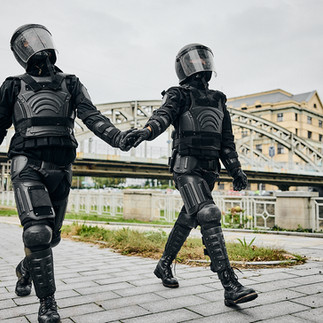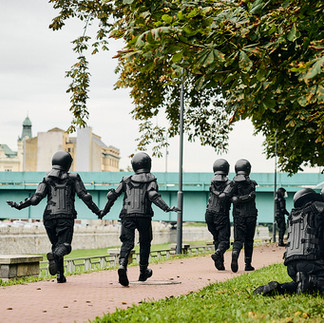Public Interventions “Serve and Protect” Through the Eyes of Nela Rusková
- Mover

- Oct 7
- 6 min read
On September 26, twelve riot police officers walked through the streets of Ostrava. For those who were familiar with the festival program, the situations were humorous. For those who had no idea the festival was happening, the scenes might have appeared rather unsettling. After all, in the current political climate, the sight of riot police can be a bit much to take in.
Personally, I can say that these interventions didn’t harm anyone — quite the opposite. They drew attention to things that today may seem forgotten, discarded, or intentionally destroyed.
What is Direct Action Theatre? Direct Action Theatre is a Czech–Norwegian collective built on the principles of action and reaction, working from political and environmental themes shaped by different landscapes and contexts. Nela H. Kornetová, Jan Husták, Ellen Røhr-Staff and Matthew Roger put on riot police uniforms to explore the relationship between power and the institution of policing. They create atypical situations filled with playfulness and emotional charge, producing moments of visual absurdity within the framework of this profession.
The group takes a clear stance against violence, war, the exploitation of nature and cruelty towards people. Through radical and fearless approaches, their work leaves strong impressions, clear opinions, and sharply articulated statements. Encounters and interactions with actual police units are not uncommon — their performances often take place in front of embassies of states acting as aggressors, under direct police supervision.
During the Ostrava intervention, the police briefly became part of the performance as well. When the group approached the Nová Karolina shopping center, a police van arrived and an officer strongly urged that the action be stopped. Fortunately, the situation was quickly resolved through dialogue — in our favor.
Opencall-workshop-fall
This year’s MOVE Fest was special also thanks to its open calls for participation, through which the organizers created space for artists and creatives to realize their work. One of these calls invited students from conservatories in Ostrava, Banská Bystrica, and the Duncan Centre in Prague to take part in Lion’s Den UNLIMITED by the collective POCKETART.
The second open call offered participation in the public intervention To Protect and Serve, which I was fortunate enough to join — and to become part of a process that was brief, yet deeply enriching. The intervention brought together invited artists Lucia Bielik, Kama Bugala, Tomáš Florea, Tomáš Janypka, Radoslav Piovarči, Amáta Skalová, and Tobiáš Worm through an open call, forming a diverse group of people from different backgrounds and practices. Each of us brought a unique energy and set of ideas, supported and guided by the original members of Direct Action Theatre — and in this exchange, our version of To Protect and Serve gradually formed in an organic way.
The first two days took the shape of a workshop. We were introduced to the group’s creative approach and methodology, and almost immediately moved into exploring impulses and situations we wished to address within the intervention. After a collective warm-up and tuning into one another, we began trying on the uniforms.
Even this initial moment was a fascinating experience for me — I had never worn something so clearly defining authority and the right to act, while simultaneously imposing physical limitation and clumsiness. Even ordinary walking became a forced spiral movement due to the body armor. Not to mention the impossibility of fully lifting one’s arms, the helmet fogging up, or the private sauna effect happening inside the suit.
What may feel claustrophobic and uncomfortable on one hand is, on the other, the safest suit one can wear — a suit in which you can practically do anything. After the basic instructions, we began learning how to fall. Here, a challenge emerged: to reprogram the mindset of contemporary dancers, who habitually seek to meet the floor with the soft parts of the body and avoid impact on bones and joints. This instinct had to be let go. We had to give ourselves over fully — falling onto knees, elbows, backs, or even our heads.
The next day we walked through the route, formed pairs or trios in which we would move through the city, tried a specific type of yoga that became part of the intervention, and learned a technique of crying for nature. These seemingly incompatible actions became the structural backbone and performative pathway of the intervention the following day.
Performance for Ostrava
The first route began at the Town Hall, continued along the river with a stop on the steps near the Miloš Sýkora Bridge, and ended at Masaryk Square. The second started at the square and led through the city to the wide staircase at Nová Karolina and back again. One route was more connected to nature, while the other had a stronger interactive component with the public. Both offered different impulses and situations to explore.
The structure of our performance moved from a group participatory arrest yoga session, accompanied by a voiceover humorously transforming yoga positions into the act of arresting a criminal. We continued with a walk focused on creating gentle, even romantic situations between the participants. This resulted in images that were absurd to the point of comical — simply by placing a riot officer in actions usually associated with intimacy and tenderness, in both monogamous and polyamorous relationships.
We then headed to the steps, where we carried out a short workshop on falling down stairs, which transitioned into a collective surrender to gravity. This was supported by music and, in the case of the outdoor performance, orange smoke. Finally, we cried for nature. Our attention was drawn to everything green: blooming or withering, growing freely, placed in a shop window, or planted in small boxes on street lamps.
During the intervention, new layers kept emerging; meanings formed, situations appeared and disappeared in quick, unpredictable rhythms. What fascinated me the most was observing the differences in perception between older adults, other adults, children, and marginalized groups. Most adults barely noticed us — they gave the group a single glance (perhaps a second, confused one) and then retreated back into their own bubbles. Older people most often showed fear and confusion. One woman approached me and asked what was happening. Once I explained, she let out a deep sigh of relief and said, “Oh, you’re just theatre, good. I thought something worse was going on.” I don’t blame her reaction.
The encounters with children were pure coincidence — for instance, when a group of preschoolers walked past us by the river. Without fear, hesitation, or restraint, they came right up to us, looked us in the eyes, and many of them even high-fived us. It was beautiful to witness pure joy and minds still untouched by the anxieties of the contemporary world.
Marginalized communities are still numerous in our country, and those present during the performance were not afraid to join in — sometimes encouraging, sometimes initiating the absurd situations. For those whose energy had faded, we tried to approach with humility, offering genuine gestures of presence and attention, if only for a moment.
Processing the emotional range between being ignored, trusted, feared, and laughed with is something that stays with me. Approaching people as an anonymous identity inside a uniform of power is delicate work — it requires both distance and deep empathy, depending on the situation. Throughout the performance, I registered reactions from compassion, cooperation, and understanding, to suspicion, indifference, and occasional mockery — which, as usual, came from misunderstanding. Being met with so many different emotions can feel overwhelming, and in such a striking costume there is nowhere to hide. In those moments, the best thing for me was to draw close to someone from the group, meet their eyes with trust, and let myself be held — by the hand or in an embrace. Simply to experience the moment together, to care for one another, to offer gentleness.
Overall, I see this experience as deeply valuable — both for my personal development and for Ostrava, which truly deserves more interventions of this kind.
Text author: Nela Rusková
Photos author: Kamil Hauptmann

Nela Rusková is a performer, maker, and choreographer — but above all, a person who has immersed herself in art as a form of communication. She graduated from the Janáček Conservatory in Ostrava and the Academy of Performing Arts in Bratislava, where she studied Dance Theatre and Performance (BA) and Choreography (MA). Beyond these institutions, she spent half a year studying at the University of Stavanger (Norway) through the Erasmus+ program.
In her work, she focuses on simplicity, detail, and the fragility of a human being existing in an overwhelmed world. She moves within the field of contemporary dance and performance in Slovakia, while remaining connected to her home region through open calls and collaborative projects. She currently works with PLAST – platform for contemporary dance, and is part of Tantelab III under the direction of the Tantehorse company in Prague.
As a performer, she has collaborated with established Slovak artists (Juraj Korec, Stanislava Vlk Vlčeková, Daniel Raček, Soňa Kúdeľová, Barbora Janáková), and her work has been presented at festivals such as Tanečno, Kiosk, NuDanceFest and MOVE Fest Ostrava.
After many years of internal debate and hesitation, she eventually realized that she does, in fact, love dance, creation, and art.










































































Comments